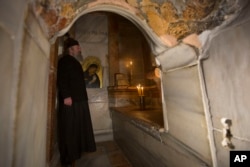A team of scientists and workers have completed repairs on what is said to be the burial place of Jesus Christ in Jerusalem’s Old City.
It was the first time that workers have repaired the religious shrine since 1810.
The project took nine months to complete. The area reopened to the public on Wednesday.
The limestone and marble structure stands at the center of the Church of the Holy Sepulcher, one of the world’s oldest religious centers.
The shrine is considered among the holiest places in Christianity. It needed urgent repairs after years of damage from water, humidity and smoke.
The Greek Orthodox, Armenian and Roman Catholic religions share ownership of the Church of the Holy Sepulcher. Disputes between them had prevented repairs from taking place on the grounds for more than 200 years.
Bonnie Burnham is with the World Monuments Fund, an American non-profit group. She told the Associated Press: "If this intervention hadn't happened now, there is a very great risk that there could have been a collapse.”
Work on the tomb finally began last year, after officials with Israel’s Antiquities Authority called the area unsafe.
The team worked mainly on repairing a small structure above the burial place. It is known as the Edicule.
Workers removed an iron cage that long surrounded the Edicule. British crews set up the cage in the 1940s to help support the walls. After the repair work, supportive equipment is no longer needed.
Workers also cleaned the shrine’s walls of black soot, which had built up from many years of visitors lighting candles. Now, the tomb is closer to its original coloring, a warm, reddish yellow color.
Antonia Moropoulou is with the National Technical University of Athens in Greece. She oversaw the repair project.
“Before this the monument was black,” she told Agence France-Presse. “This is the actual color of the monument, the color of hope.”
Each of the three religious denominations reportedly donated money toward the restoration project. Jordan’s King Abdullah also reportedly made a donation.
The repairs cost more than $3 million.
I’m Ashley Thompson.
Ashley Thompson adapted this article for VOA Learning English. Her story was based on reports from Reuters and the Associated Press, plus additional materials. George Grow was the editor.
________________________________________________________________
Words in This Story
shrine - n. a place connected with a holy person or event where people go to worship
cage - n. a box made of wire or metal bars in which people keep animals or birds
original - adj. happening or existing first or at the beginning
denomination - n. a religious group









